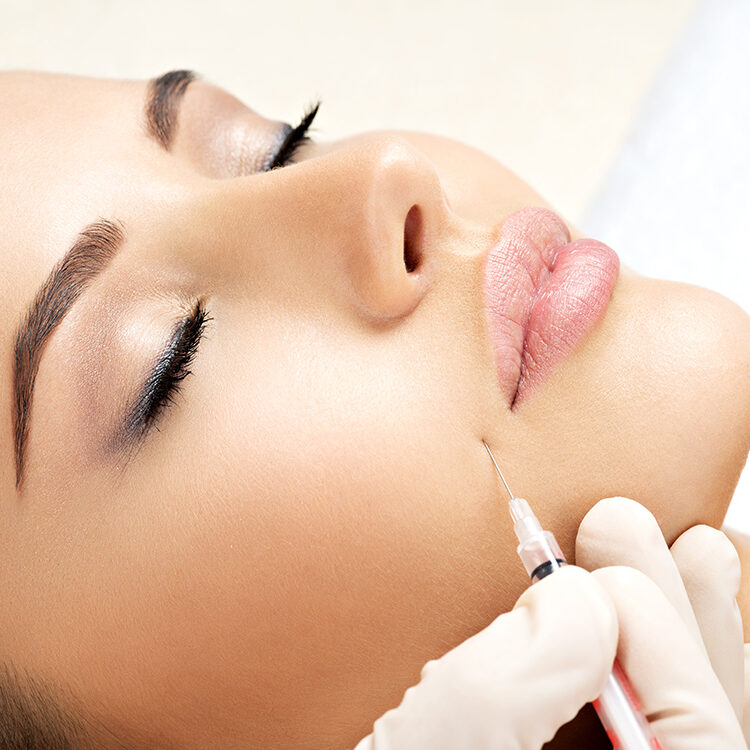Botox Treatment
Botox Treatment for TMJ and Jaw Tension
The temporo-mandibular joint (TMJ) is located on both sides of the head at the point where the jawbone meets the skull. The temporo-mandibular joint is used during talking, eating, swallowing, and other everyday activities. If this joint becomes displaced or is overworked through excessive teeth grinding, a person may suffer severe tension headaches, as well as sharp pain in the jaw.
Botox was once reserved for lessening the tell-tale signs of aging, such as annoying wrinkles and frown lines. But more recently Botox injections are being used frequently in dental offices as a great alternative treatment for more troublesome maladies such as TMD, which may include headache, clenching/grinding and sleep bruxism. Scientific studies have shown that patients who received Botox injections experienced significant improvements in pain, function, ability to open their mouth and levels of tenderness to palpation. Botox relieves jaw tension by making muscles unable to engage in the powerful, often unconscious movement of the jaw that produces headaches and pain.
What's Involved in Botox TMJ Treatment?
Botox is injected into the temporalis, frontal and masseter muscles that together can cause jaw pain and headaches. Botox works by blocking nerve signals that cause uncontrollable muscle movements, essentially relaxing the muscles.
Botox injections take only 10 to 15 minutes and remain effective for anywhere between two and six months. Therefore, like its cosmetic counterpart, Botox TMD treatments must be repeated every few months depending on the patient. Most patients who receive Botox treatment regularly after a year to two, have notice the decrease frequency needs for retreatment due to the fact that their muscles have atrophied over time. Therefore, the need for Botox treatment can decrease from 3-4 times a year to maintenance treatment of 1-2 times a year. If you have TMD and Dr. Sandeep Dhaliwal determine(s) that you are a good candidate for this treatment, how often you'll need to receive Botox injections to relieve symptoms will depend on the severity of your condition.
Risks and Benefits of Botox Treatment for Jaw Tension
The benefits of Botox treatment for TMD are many. For people suffering from soreness and pain resulting from problems with the temporo-mandibular joint, Botox injections often provide substantial relief. While reducing the ability of facial muscles to engage in problematic grinding, Botox allows them to perform daily activities such as talking, chewing, and swallowing. This makes the Botox alternative treatment for jaw tension a convenient, effective option for many people. In addition, the treatment can help safeguard dental health, since excessive grinding can result in worn down teeth and damaged gums that may require costly treatment.
While botox treatment for TMJ disorders appears to be safe, certain medications, intoxicants, and other substances can minimize or negatively impact the effectiveness of Botox injections. For this reason, patients should honestly disclose any medication or substance use with Dr. Sandeep Dhaliwal prior to treatment. Although complications are rare, but in some cases, patients have experienced bruising and bleeding at injection sites, or excessive paralysis of the muscles in the areas treated.
Cost of Botox TMJ Treatment
The cost of the Botox TMD treatment will vary based on where you live and receive treatment and the severity of your condition (and therefore, how many Botox injections are needed). Botox treatment is usually charged on a per-visit basis.
Many dental insurance companies ACCEPT Botox TMD treatments. However, every insurance policy is different, therefore, it will be your ultimate responsibility for the service fee if it is determined not to be covered under your insurance plan. Southwest Dental Clinic`s knowledgeable staff is happy to help you inquire from your insurance company the eligibility of your plan for Botox treatment. Other financing options may be available.
If you are looking for a dentist in Edmonton for Botox Treatment, please call us at (780) 435-5515 and book an appointment with Dr. Sandeep Dhaliwal.

